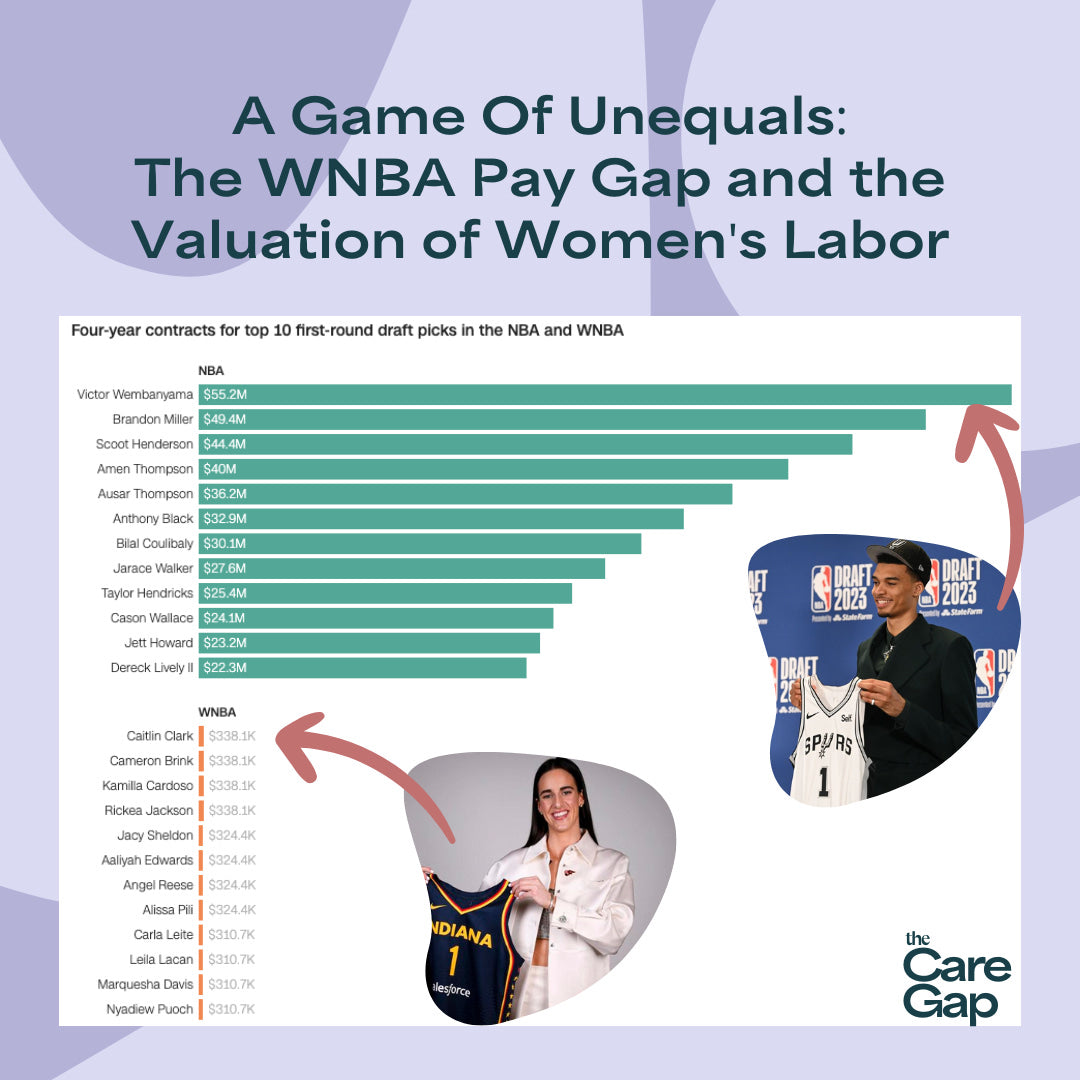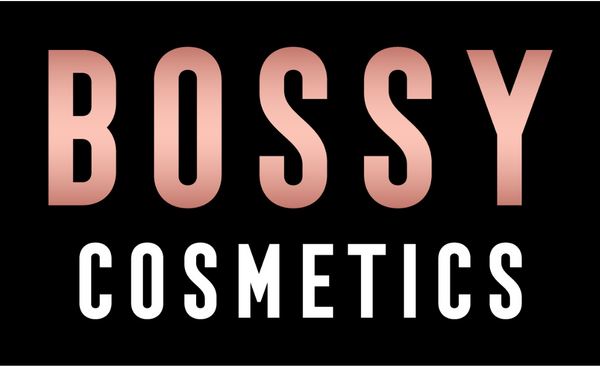
A Game Of Unequals: The WNBA Pay Gap and the UnderValuation of Women's Labor
Share
This blogpost is written by Blessing Adesiyan, Founder & CEO of MH WorkLife and Executive Director, Caring Africa where she is on a mission to close the care gap for women, workplaces, and economies.
_______________________________
I am still on a high from the South Carolina win and Dawn Staley getting her flowers as one of the most decorated coaches in women’s sport history. However, let's shift gears to the more current events - the WNBA pay gap. Caitlin Clark, the number 1 draft pick in the 2024 Women’s National Basketball Association (WNBA), will earn a salary of $338.1K in the next four years. In contrast, the 2024 National Basketball Association (NBA) #1 draft pick Victor Wembanyama will earn $55.2M in the nest four years. Mathematically, Victor Wembanyama's salary is approximately 163.27 times greater than that of Caitlin Clark. This gap is not just a matter of sports economics; it reflects a deeper, more pervasive issue that spans across all sectors of labor: the undervaluation of women’s work. Even President Biden is shocked that Clark’s salary will be 0.7% of her male equivalent. That is how wide this gap is.
There are some intriguing correlations and social perceptions that link the way we view women's sports, like the WNBA, with broader societal expectations about women's roles as caregivers and their perceived economic value. These connections stem from deeply ingrained gender norms and can significantly impact both the visibility and valuation of women’s sports. Let’s explore a few key aspects:
-
Perceived Economic Value: The historical undervaluation of women’s work, whether in the home or the labor market, parallels the undervaluation of women's sports. There's a persistent notion that activities traditionally dominated by women, including caregiving, deserve less economic recognition. This perspective can bleed into sports, where the athletic performance of women is often undervalued compared to men’s, reflected in disparities in pay, sponsorship, and media attention.
-
Media Coverage and Audience Engagement: The assumption that women, primarily tasked with caregiving, may not have time to engage as spectators in sports, affects how media companies invest in and cover women’s sports. If media executives believe that a significant portion of potential viewers (i.e., women) are too busy with caregiving duties to watch sports, they might be less inclined to broadcast women’s games, resulting in lower ratings and reduced advertising revenue. This becomes a self-fulfilling prophecy where limited coverage leads to perceived low interest, further justifying the initial limited coverage.
-
Social and Cultural Norms: Cultural norms that see women primarily as caregivers can also influence who becomes a sports fan or participant from a young age. If girls are subtly steered towards caregiving roles rather than being encouraged to engage in or follow sports, this can reduce the base of fans and players needed to grow women's sports into a more prominent and economically powerful sector.
-
Marketing and Sponsorship: Sponsors might be hesitant to invest heavily in women's sports if they perceive that the audience for these events is limited or less engaged due to their caregiving responsibilities. This impacts the financial growth and overall professionalization of women's leagues. Conversely, the marketing strategies often employed can reinforce certain stereotypes or fail to resonate with broader audiences, thereby not effectively expanding the viewer base.

The WNBA Pay Gap
The financial disparities between the WNBA and NBA are stark and multifaceted. While Caitlin Clark, a standout performer in the WNBA, earns an annual salary of just $76,535, even the least experienced players in the NBA enjoy a minimum salary that eclipses $1.1 million. This disparity is not just a reflection of individual leagues but a stark illustration of the broader economic undervaluation of women's sports.
-
Revenue Streams and Visibility: One of the fundamental reasons for this pay gap lies in the differing revenue streams between the two leagues. The NBA enjoys a lucrative global viewership, substantial broadcasting rights deals, and hefty sponsorship agreements, which collectively generate billions of dollars annually. In contrast, the WNBA, while growing, commands smaller audiences, resulting in less lucrative TV deals and fewer sponsorship dollars. In the 2022 season, for instance, the WNBA generated around $60 million in revenue, a fraction of the NBA’s multi-billion dollar intake.
-
Media Coverage and Sponsorship: Media coverage significantly influences revenue, as greater visibility can drive larger audiences and attract more substantial sponsorship deals. Unfortunately, women's sports receive only a small slice of the overall sports media coverage due to reasons I have shared earlier, which inevitably impacts revenue potentials. For the WNBA, this lack of coverage perpetuates a cycle of low visibility and minimal investment, further widening the pay gap.
-
Structural Inequities: The salary structures of the leagues also reflect deeper systemic issues. The NBA, with its long history and established fan base, has been able to negotiate collective bargaining agreements that ensure players a significant share of league revenues. The WNBA is making strides, with recent agreements improving average salaries and benefits, but the gap remains substantial.
-
The Impact of Public Perception: Cultural attitudes towards women's sports also play a critical role in this disparity. Despite the high level of competition and entertainment they offer, women’s sports leagues often face stereotypes about their legitimacy and the quality of play, which can deter potential sponsors and broadcasters from investing at levels seen in men’s sports.
The pay gap in the WNBA is not just a result of economic factors but is also deeply entangled with social and cultural perceptions. Addressing this issue requires not only changes within sports economics but also a shift in how society values and supports women's sports. As we move into the next sections, we will explore how these economic disparities in professional sports reflect broader societal trends regarding the undervaluation of women’s work, both paid and unpaid.

Implications and Moving Forward
The significant disparities in compensation and recognition between WNBA and NBA players are symptomatic of broader societal issues that affect women across all professions. Understanding and addressing these disparities is crucial not only for the world of sports but also for advancing gender equality in the workforce at large.
-
Policy Changes in Sports Organizations: One avenue for change lies in the policies governing sports organizations. The WNBA can work towards better revenue-sharing models and negotiate media rights deals that ensure more equitable distribution of the generated revenue. This involves partnerships with broadcasters and sponsors who are committed to promoting women's sports as vigorously as they promote men’s sports.
-
Enhanced Media Coverage: Increasing the visibility of women's sports through enhanced media coverage can drive higher viewership and, consequently, higher revenue. Media companies, influenced by public demand and responsible portrayal, must commit to providing more airtime to women's sports. This increased visibility not only boosts revenue but also helps in changing public perceptions about the value of women's sports. The visibility of athletes like Caitlin Clark and Angel Reese can also help to draw attention not only to their personal achievements but also to the league as a whole. Their success stories can inspire young girls to pursue sports, increase fan engagement, and attract media coverage. More visibility can lead to better sponsorship deals and broadcasting contracts, which are crucial for the financial health of the league.
-
Public Advocacy, Allies, and Awareness: Public advocacy is critical in shifting cultural and social norms that affect the valuation of women's sports. Serena Williams expressing interest in the WNBA is significant. As a global sports icon, her involvement can bring attention and legitimacy, attracting new fans and sponsors. Similarly, when male athletes like Stephen Curry and Lebron James show their support for the WNBA, it helps to break down the gender barriers and challenges the stereotype that women's sports are of lesser value. Campaigns that highlight the achievements and struggles of women athletes can educate the public and mobilize support for more equitable treatment in sports.
-
Corporate Sponsorships: Encouraging more corporations to sponsor women's sports can significantly impact salary disparities. Sponsorships driven by a genuine commitment to gender equality, rather than mere tokenism, can provide the financial support needed to elevate the status and pay of women athletes. The momentum generated by stars and advocates needs to be capitalized on by the leagues, teams, and corporate sponsors to build a sustainable business model. This includes long-term investments in marketing, community engagement, and youth programs that will cultivate a dedicated fan base and ensure the growth of women's sports.
-
Education and Community Programs: Education programs that start at the grassroots level to encourage young girls to participate in sports can also help change the landscape. Building a larger base of participants and fans from a young age can contribute to long-term changes in viewer demographics and, subsequently, in advertising and sponsorship decisions.
The journey towards closing the pay gap in professional sports, particularly between the WNBA and NBA, is intertwined with the broader struggle for gender equity. By addressing these disparities through a combination of policy changes, increased visibility, and public advocacy, we can hope to see a future where the value of an athlete's contribution is not determined by their gender but by their skill, dedication, and impact on the sport.
